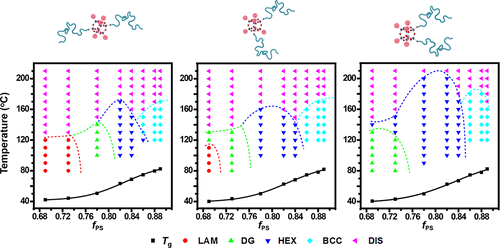当前位置:
X-MOL 学术
›
Macromolecules
›
论文详情
Our official English website, www.x-mol.net, welcomes your
feedback! (Note: you will need to create a separate account there.)
Influence of Regio-Configuration on the Phase Diagrams of Double-Chain Giant Surfactants
Macromolecules ( IF 5.1 ) Pub Date : 2018-01-12 00:00:00 , DOI: 10.1021/acs.macromol.7b02383 Xiao-Man Wang 1 , Yu Shao 1, 2 , Peng-Fei Jin 1 , Wenbo Jiang 3 , Wei Hu 4 , Shuguang Yang 2 , Weihua Li 3 , Jinlin He 5 , Peihong Ni 5 , Wen-Bin Zhang 1
Macromolecules ( IF 5.1 ) Pub Date : 2018-01-12 00:00:00 , DOI: 10.1021/acs.macromol.7b02383 Xiao-Man Wang 1 , Yu Shao 1, 2 , Peng-Fei Jin 1 , Wenbo Jiang 3 , Wei Hu 4 , Shuguang Yang 2 , Weihua Li 3 , Jinlin He 5 , Peihong Ni 5 , Wen-Bin Zhang 1
Affiliation

|
It has been established that a minute difference of the primary chemical and topological structures influences the self-assembly behaviors of giant surfactants; however, the regio-configuration effect has been rarely reported. Herein, we report a systematic study on the self-assembly behaviors of a series of double-chain giant surfactant regio-isomers, which consist of a hydrophilic polyhedral oligomeric silsesquioxane (POSS) head and two identical hydrophobic polystyrene (PS) tails with various molecular weights tethered in para-, meta-, and ortho-configurations, respectively. Small-angle X-ray scattering and transmission electron microscopy characterizations have been combined to investigate the phase behaviors of each sample and construct the phase diagrams for the three isomers with respect to the molecular weights of PS tails. It is observed that the regio-configuration significantly impacts the self-assembly behaviors of the giant surfactant isomers, including order-to-disorder (ODT) and order-to-order (OOT) transitions. In each isomer system, the order-to-disorder transition temperature (TODT) changes nonmonotonically with the length of PS tails, which is generally similar to the variation of TODT for block copolymers but also exhibits some peculiar features associated with the rigid conformation of headgroup. With equal length of PS tails, TODT of the three isomers is in the descending order of ortho > meta > para. There is a pronounced and systematic phase boundary shift to lower volume fraction of PS (fPS) and to lower temperatures from para to meta to ortho. This is closely related to the compounds’ regio-configuration and rigid 3D conformation of the headgroup and may be understood through the lower effective fPS as two tails get further apart. These findings elucidate the sophisticated effect of the regio-configuration on self-assembly behaviors. It suggests regio-configuration as an additional factor in tuning the self-assembly of giant surfactants at sub-10 nm or even sub-5 nm length scales, which is of significant technical importance.
中文翻译:

区域构型对双链巨型表面活性剂相图的影响
已经确定,主要化学结构和拓扑结构的微小差异会影响巨型表面活性剂的自组装行为。然而,关于区域构型效应的报道很少。在这里,我们报告了一系列的双链巨型表面活性剂区域异构体的自组装行为的系统研究,该结构由亲水性多面体低聚倍半硅氧烷(POSS)头和两个相同的具有不同分子的疏水性聚苯乙烯(PS)尾部组成在对-,元-和正交中捆绑的权重-配置。小角X射线散射和透射电子显微镜特性已被结合起来,以研究每个样品的相行为,并针对PS尾部的分子量构建三种异构体的相图。观察到,区域构型显着影响巨大的表面活性剂异构体的自组装行为,包括从有序到无序(ODT)和有序到有序(OOT)的转变。在每个异构体系统中,有序到无序转变温度(T ODT)随PS尾部的长度非单调变化,这通常与T ODT的变化相似对于嵌段共聚物而言,它还表现出一些与头基的刚性构象有关的独特特征。在PS尾部长度相等的情况下,这三个异构体的T ODT的排列顺序为邻位> meta >对位。有一个明显而系统的相界转移,降低了PS(f PS)的体积分数,降低了从对位到间位到邻位的温度。这与化合物的区域构型和头基的刚性3D构象密切相关,可以通过较低的有效f PS来理解因为两条尾巴越来越远。这些发现阐明了区域构型对自组装行为的复杂影响。这表明区域构型是调节亚表面尺寸小于10 nm或什至5 nm以下的巨型表面活性剂自组装的另一个因素,这在技术上具有重要意义。
更新日期:2018-01-12
中文翻译:

区域构型对双链巨型表面活性剂相图的影响
已经确定,主要化学结构和拓扑结构的微小差异会影响巨型表面活性剂的自组装行为。然而,关于区域构型效应的报道很少。在这里,我们报告了一系列的双链巨型表面活性剂区域异构体的自组装行为的系统研究,该结构由亲水性多面体低聚倍半硅氧烷(POSS)头和两个相同的具有不同分子的疏水性聚苯乙烯(PS)尾部组成在对-,元-和正交中捆绑的权重-配置。小角X射线散射和透射电子显微镜特性已被结合起来,以研究每个样品的相行为,并针对PS尾部的分子量构建三种异构体的相图。观察到,区域构型显着影响巨大的表面活性剂异构体的自组装行为,包括从有序到无序(ODT)和有序到有序(OOT)的转变。在每个异构体系统中,有序到无序转变温度(T ODT)随PS尾部的长度非单调变化,这通常与T ODT的变化相似对于嵌段共聚物而言,它还表现出一些与头基的刚性构象有关的独特特征。在PS尾部长度相等的情况下,这三个异构体的T ODT的排列顺序为邻位> meta >对位。有一个明显而系统的相界转移,降低了PS(f PS)的体积分数,降低了从对位到间位到邻位的温度。这与化合物的区域构型和头基的刚性3D构象密切相关,可以通过较低的有效f PS来理解因为两条尾巴越来越远。这些发现阐明了区域构型对自组装行为的复杂影响。这表明区域构型是调节亚表面尺寸小于10 nm或什至5 nm以下的巨型表面活性剂自组装的另一个因素,这在技术上具有重要意义。









































 京公网安备 11010802027423号
京公网安备 11010802027423号